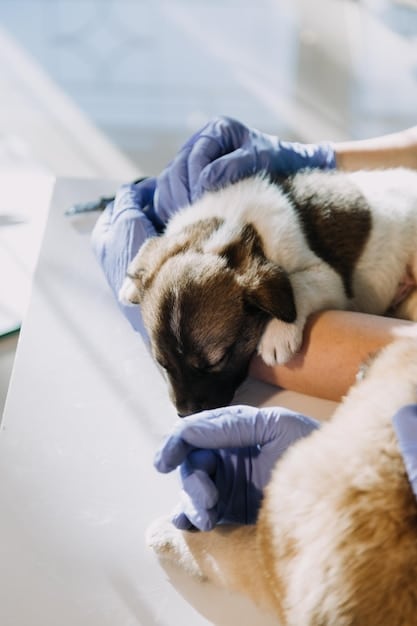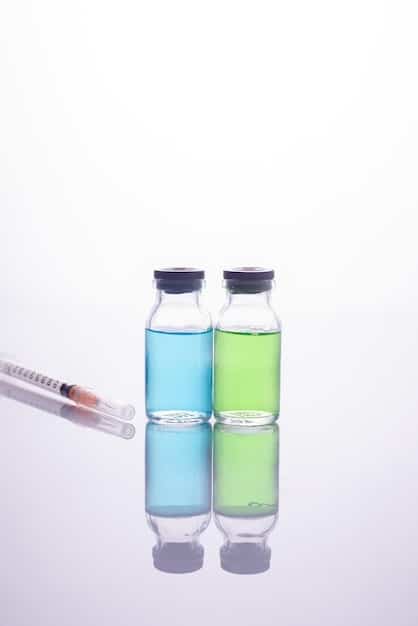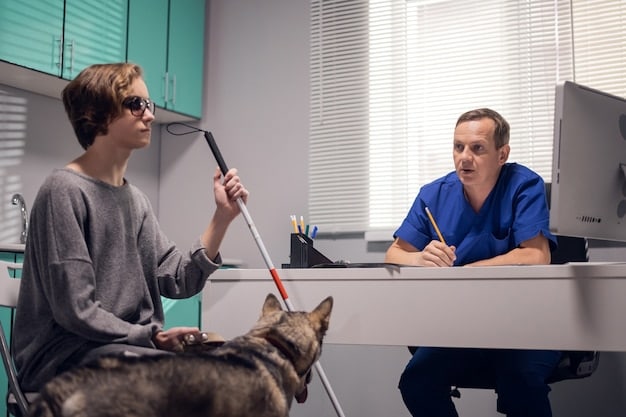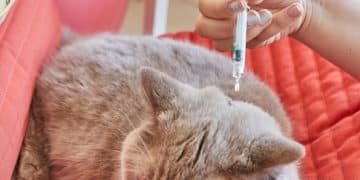Pet Vaccinations: Latest Advances in Disease Prevention

The latest advances in pet vaccinations offer enhanced protection against preventable diseases through innovative vaccine formulations, improved delivery methods, and a better understanding of pet immune responses, ensuring healthier and longer lives for our beloved companions.
Ensuring the health and well-being of our pets is a top priority for any responsible owner. One of the most effective ways to protect our furry friends from serious and potentially fatal diseases is through vaccination. The latest advances in pet vaccinations: protecting your pet from preventable diseases, have revolutionized veterinary medicine, offering enhanced immunity and reducing the risk of adverse reactions.
Understanding the Importance of Pet Vaccinations
Vaccinations are a cornerstone of preventive healthcare for pets. They work by stimulating the immune system to produce antibodies that recognize and fight off specific disease-causing organisms. This protection can last for several years, or even a lifetime, depending on the vaccine and the individual animal.
Protecting pets through vaccinations is not only a personal responsibility but it also has far-reaching community health implications, considering pets can be carriers of certain diseases.
Core vs. Non-Core Vaccines
Veterinary vaccines are generally categorized as either core or non-core. Core vaccines are recommended for all pets, regardless of their lifestyle or geographic location. These vaccines protect against diseases that are highly contagious, pose a significant risk of morbidity or mortality, or have zoonotic potential (meaning they can be transmitted from animals to humans).
- Core vaccines for dogs: Include protection against canine parvovirus, distemper, adenovirus, and rabies.
- Core vaccines for cats: Include protection against feline panleukopenia, calicivirus, herpesvirus, and rabies.
Non-Core Vaccines: Tailored to Your Pet’s Needs
Non-core vaccines are recommended based on individual risk factors, such as lifestyle, geographic location, and exposure to other animals. These vaccines protect against diseases that are less common or pose a lower risk of serious illness.
- Examples of non-core vaccines for dogs: Include protection against Bordetella bronchiseptica (kennel cough), Leptospirosis, Lyme disease, and canine influenza.
- Examples of non-core vaccines for cats: Include protection against feline leukemia virus (FeLV), feline immunodeficiency virus (FIV), and Chlamydophila felis.
Consulting with your veterinarian is essential to determine the best vaccination protocol for your pet, based on their individual needs and risk factors. By understanding core and non-core vaccines, pet owners can make informed decisions about protecting their pets’ health. This foundation of knowledge helps ensure pets receive the necessary protection while avoiding unnecessary vaccinations.
Advancements in Vaccine Technology
The field of vaccine technology is constantly evolving, leading to more effective and safer vaccines for our pets. These advancements include the development of recombinant vaccines, adjuvants that boost the immune response, and vaccines that offer broader protection against multiple strains of a disease.
Innovations in vaccine technology not only enhance protection, but also improve animal welfare; fewer adjuvants and advanced delivery mean less stress during vet visits.
Recombinant Vaccines: Targeted Protection
Recombinant vaccines use genetic engineering to insert a portion of the disease-causing organism’s DNA into a harmless carrier virus or bacteria. This carrier then produces the antigen, which stimulates the immune system to develop antibodies without exposing the animal to the actual disease, thus minimizing risks of any reaction.
Recombinant vaccines are considered safer than traditional vaccines because they do not contain the entire disease-causing organism, reducing the risk of adverse reactions.
Adjuvants: Enhancing the Immune Response
Adjuvants are substances added to vaccines to enhance the immune response. They work by stimulating the immune system to produce more antibodies and develop a stronger, longer-lasting immunity. Newer adjuvants are designed to be more effective while minimizing inflammation and other side effects.
The use of advanced adjuvants is particularly beneficial in older animals or those with weakened immune systems, ensuring they receive adequate protection from vaccinations.

Ongoing research is focused on developing even more effective and safer adjuvants, as scientists gain a deeper understanding of how the immune system works. This research is expected to lead to the development of vaccines that provide even broader and longer-lasting protection against a variety of diseases.
Navigating Vaccination Schedules and Boosters
Creating a vaccination schedule is foundational to protect pets from diseases. Following recommended protocols for initial vaccinations and booster shots is crucial for maintaining immunity.
Understanding the importance of following advised vaccine schedules empowers pet owners to protect their animals and the community.
Initial Vaccination Series for Puppies and Kittens
Puppies and kittens receive antibodies from their mothers through colostrum (the first milk). However, this maternal immunity wanes over time, leaving them vulnerable to infection. To ensure adequate protection, puppies and kittens typically receive a series of vaccinations starting at 6-8 weeks of age and continuing every 3-4 weeks until they are 16 weeks old.
- For puppies: This series typically includes vaccinations against canine parvovirus, distemper, adenovirus, and parainfluenza virus.
- For kittens: This series typically includes vaccinations against feline panleukopenia, calicivirus, and herpesvirus.
Booster Shots: Maintaining Long-Term Immunity
After the initial vaccination series, booster shots are needed to maintain long-term immunity. The frequency of booster shots depends on the vaccine, the animal’s age, lifestyle, and risk factors. Some vaccines provide protection for several years, while others require more frequent boosters.
Veterinarians tailor booster schedules to best fit an individual animal’s needs and potential exposure risks based on current best practices and scientific validation.
Following recommended vaccination schedules and booster protocols is essential for ensuring that your pet remains protected against preventable diseases throughout their life. Consulting with your veterinarian is the best way to determine the appropriate vaccination schedule for your pet, based on their individual needs and risk factors. Regular check-ups and discussions with your vet will help keep your pet healthy and safe.
Addressing Concerns and Misconceptions
Despite the clear benefits of pet vaccinations, some owners harbor concerns about potential side effects or over-vaccination. Discussing these concerns openly with a veterinarian is crucial for making informed choices.
Open communication of concerns and relying on evidence-based guidelines are crucial steps towards addressing fears and promoting responsible pet care.
Addressing Common Concerns
While vaccines are generally safe and effective, they can sometimes cause mild side effects, such as fever, lethargy, or local discomfort at the injection site. These side effects are usually temporary and resolve within a few days. However, in rare cases, more serious adverse reactions can occur, such as allergic reactions or injection-site sarcomas (in cats).
Veterinarians carefully weigh the benefits of vaccination against the potential risks, and take precautions to minimize the risk of adverse reactions.
Understanding Over-Vaccination
Over-vaccination refers to the practice of administering vaccines more frequently than necessary. Some pet owners worry that over-vaccination can lead to immune system overload and increase the risk of adverse reactions. However, scientific evidence suggests that over-vaccination is not a significant concern for most pets.

- Many vaccines provide protection for several years, and annual boosters may not always be necessary.
- Veterinarians are increasingly using titer testing to assess an animal’s immunity level and determine whether a booster shot is needed.
By addressing concerns and misconceptions about pet vaccinations openly and honestly, veterinarians can help pet owners make informed decisions about their pets’ healthcare. Staying informed about the benefits and risks of vaccination, and maintaining open communication with your veterinarian are essential for ensuring your pet receives the best possible care.
Future Trends in Pet Vaccinations
The future of pet vaccinations holds exciting possibilities, including the development of new vaccines that offer broader protection against multiple diseases, needle-free vaccine delivery systems, and personalized vaccination protocols based on an individual animal’s genetic makeup.
Continuous innovation in pet vaccinations promises more effective, safer, and convenient options for protecting our pets’ health.
Multivalent Vaccines: Comprehensive Protection
Multivalent vaccines, also known as combination vaccines, protect against multiple diseases with a single injection. These vaccines offer several advantages, including reducing the number of injections needed, minimizing stress for the animal, and saving time and money for the pet owner.
Ongoing research is focused on developing even more comprehensive multivalent vaccines that can protect against a broader range of diseases.
Needle-Free Vaccine Delivery: Minimizing Stress
Needle-free vaccine delivery systems use alternative methods to administer vaccines, such as nasal sprays, oral formulations, or transdermal patches. These systems offer several advantages, including reducing pain and stress for the animal, eliminating the risk of needle-stick injuries, and improving vaccine compliance.
- Needle-free delivery systems are particularly useful for animals that are difficult to handle or have a fear of needles.
The development of needle-free vaccine delivery systems is an ongoing area of research, with promising results. As these technologies become more widely available, they are expected to revolutionize the way vaccines are administered to pets.
Innovations in pet vaccination are expanding; researchers are exploring methods to tailor them to suit individual genetic profiles, maximizing effectiveness while limiting adverse effects.
Legal Compliance and Rabies Vaccinations
Vaccinating pets against rabies is not only a matter of personal responsibility but also a legal requirement in many jurisdictions.
Compliance with rabies vaccination laws protects individual pets, the wider animal population, and public health by preventing the spread of this deadly zoonotic disease.
Understanding Rabies Vaccination Laws
Rabies is a fatal viral disease that affects the central nervous system. It is transmitted through the saliva of infected animals, and can affect all mammals, including humans. Rabies vaccination is highly effective in preventing the disease, and is required by law in most states and countries.
- Rabies vaccination laws vary by region, but generally require all dogs, cats, and ferrets to be vaccinated against rabies.
- Some jurisdictions may also require rabies vaccination for other animals, such as horses or livestock.
Consequences of Non-Compliance
Failure to comply with rabies vaccination laws can result in fines, quarantine of the animal, or even legal action. In some cases, unvaccinated animals that are exposed to rabies may be euthanized to prevent the spread of the disease.
If traveling internationally or moving to a different state with a pet, it’s essential to research local regulations regarding rabies vaccinations to guarantee legal compliance.
| Key Point | Brief Description |
|---|---|
| 💉 Core Vaccines | Essential for all pets, protecting against severe diseases like rabies and distemper. |
| 🛡️ Recombinant Vaccines | Use genetic engineering for safer immunization, minimizing risk of adverse reactions. |
| 📅 Booster Shots | Maintain long-term immunity; schedules vary based on vaccine and pet’s lifestyle. |
| 🚫 Needle-Free Options | Emerging methods like nasal sprays reduce stress and improve vaccine compliance. |
Frequently Asked Questions (FAQs)
▼
Core vaccines like parvovirus, distemper, adenovirus, and rabies are vital for puppies. Non-core vaccines such as Bordetella and Lyme disease may be recommended based on lifestyle and geographic location.
▼
Booster frequency varies depending on the vaccine type and risk factors. Some vaccines require annual boosters, while others are effective for longer periods. Your veterinarian can advise on your cat’s specific needs.
▼
While generally safe, mild side effects like fever or discomfort may occur. Severe reactions are rare. Veterinarians weigh benefits against risks and take precautions to minimize adverse reactions.
▼
Recombinant vaccines use genetic engineering to stimulate immunity without exposing the pet to the entire disease-causing organism, reducing the risk of adverse reactions compared to traditional vaccines.
▼
Rabies is a fatal disease transmitted through saliva of infected animals and poses a public health risk. Vaccinating pets is legally mandated to prevent the spread of rabies to animals and humans.
Conclusion
Staying abreast of the latest advances in pet vaccinations significantly contributes to a healthier, happier life for our animal companions. By understanding the types of vaccines, schedules, and addressing concerns, pet owners can work with veterinarians to create personalized protection plans, ensuring a future where preventable diseases pose less of a threat.





